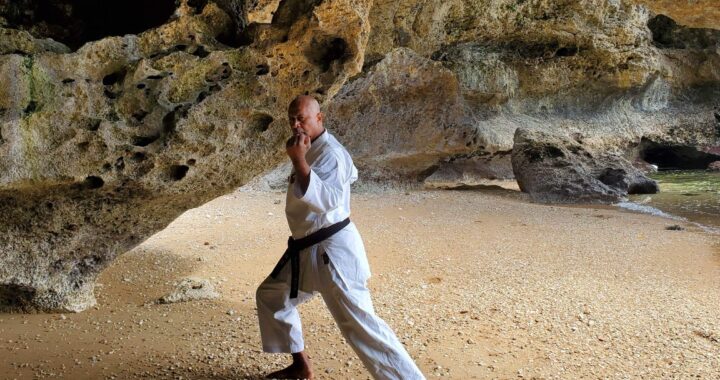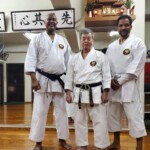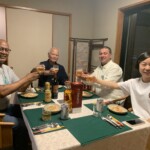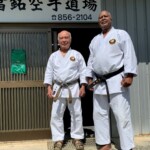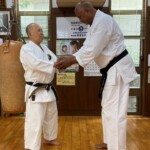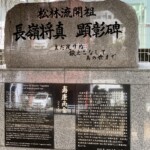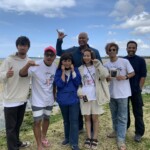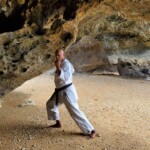Okinawa is the birthplace of Karate, and many people travel from around the globe to practice with the Sensei of the current time. Many come for their kata to be corrected, a better understanding of waza, the practice of Kobudo and for authentic rank promotion within their organizations and groups. In 2019, a year before Covid changed the world, I too traveled to Okinawa for some of the same reasons and met some terrific people and people who practiced many different styles of Karate, Judo, Kendo and Aikido. I have been practicing forms of Karate since 1984 and Matsubayashi Ryu since 1991, but it was that trip in May that pulled me close to the World Matsubayashi Karate-Do Association (WMKA). I then returned to the United States and studied with Scott Mastin Sensei to understand the differences of what I have practiced and what is practiced in the WMKA. Today I am a member of the WMKA as a yudansha under Mastin Sensei, and as a WMKA Dojo owner.
I recently traveled to Okinawa from February 22, 2023, through March 10, 2023, with one of my students to study with the leaders of the WMKA. We stayed in the Kadena area close to a dear friend so we could experience more of the island. Mr, Riki Nomura arranged a wonderful and well-rounded practice schedule that would allow us to experience five different Sensei dojos.
On February 24th Mr. Riki Nomura sent me an email notifying me that Taira Sensei welcomed our travel and invited us to join the WMKA group practice at the Okinawa Karate Kaikan on February 26th for a demonstration on March 5th. Honored and humbled, we joined the group and found the two-hour workout to be very informative, precise and enjoyable. During the rehearsal, I was reacquainted with Anthony Gibson Sensei from Canada who would be very instrumental in helping me navigate some of the upcoming training sessions. One week later, I found myself with the same group performing kata for the Governor of Okinawa.
My student, Robert Akittta, and I practiced twice a day and three times on another when we added a training session at the Asato Dojo. One could never articulate the intense technical training provided by Yoshitake Taira Hanshi, tempered with his understanding of our physical limitations. Toshimitsu Arakaki Hanshi’s training was very focused on the speed and power of the technique delivered along with the correct timing. Arakaki Sensei’s warm personality and desire to socialize and communicate with us was certainly unexpected but welcomed. Arakaki Sensei made us feel like we belonged and were connected to the WMKA family. In addition, we trained with Iwao Tome Hanshi who provided the feeling of working out in one’s grandfather’s dojo. Tome Sensei concentrated on preparing me for a path forward to my next rank promotion. I have trained with these three Hanshi in the past and they all remembered me from previous training sessions and seminars which made us feel like we were connected to the Karate family in Okinawa.
Mr. Nomura also arranged and added one training session with Tetsuo Makishi Sensei at his dojo in Naha. This was my first-time meeting Makishi Sensei and I found him to be pleasant and loving with his students and very welcoming to us as newcomers. I could see Makishi Sensei has been well trained, and his leadership skills are strong, for I watched him organize the WMKA group performance with patience, skill and poise.
I had never met Masao Shinzato Sensei, but I had seen him highlighted on YouTube with Jesse Enkamp. I spent two training sessions with Shinzato Sensei and found Passai is one of, if not his favorite kata. Sensei showed me his kata several times, helped me with mine and shared some oyo bunkai with me. Shinzato Sensei was very pleasant and welcoming and on my last visit we also shared some fruit together. I have trained with James Pankiewicz Sensei at Arakaki Sensei’s Dojo and knew he was a very powerful Karataka. Pankiewicz Sensei invited us to workout with him at his dojo (Asato Dojo) and we had a wonderful class studying Chinto and many applications within.
I had a wonderful time studying Karate during my visit, but the trip was enhanced so much by experiencing the food in public places such as the fish market in the Kokusai Dori (International Street) mall. Watching the performance of Okinawa dance and drum in the market areas and sharing conversation with a total stranger was another highlight. The food in Okinawa is another part of its culture, with cuisine that is distinctly different from the rest of Japan. One of the local dishes that I enjoyed on a regular basis was Okinawa Soba and soki soba, which is made with pork ribs.
The people of Okinawa are very polite, patient with one another and connected in the community. I was in awe not to see any signs of violence, litter or homelessness. The community revere and uphold their aging citizens as elders and productive assets. Respect for elders is a core value in Okinawan culture and it is customary to speak politely and differentially to them. The main Island has a population of 10 million people and yet I only saw one motor vehicle accident. That statement alone attests to the patience and courtesy that the islanders show for each other. There is an Okinawa proverb, “Ichariba Choode” that translates to, “Although we met only once, even by chance, we are friends forever.” and that is exactly how I felt when I left the island.
Anthony Roberts
Columbus Shorinryu Karate Dojo
Click on an image for a full-size gallery:

